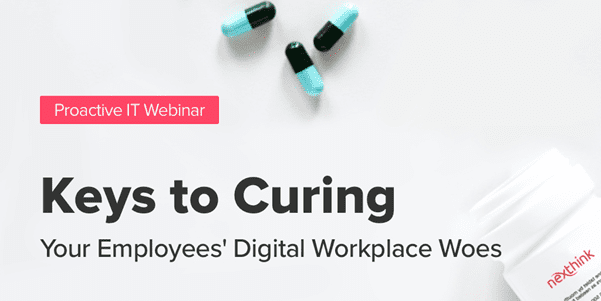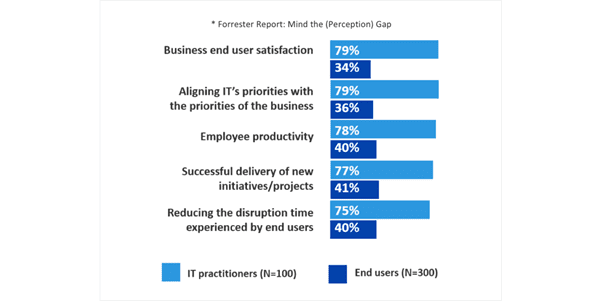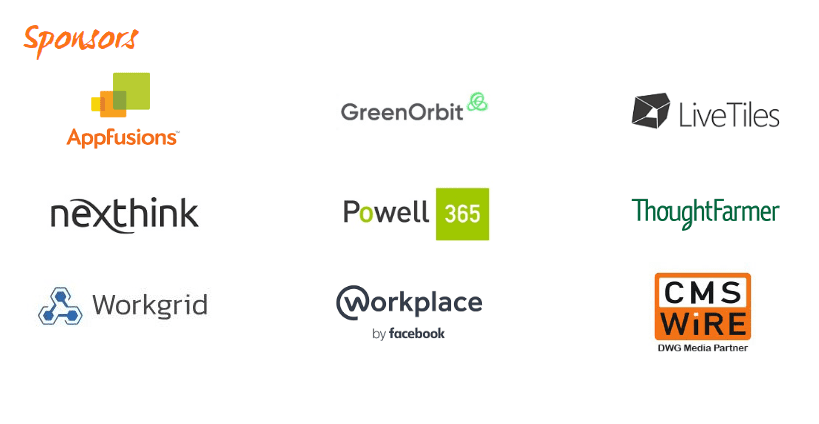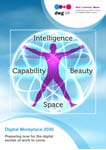Keys to curing your employees’ digital workplace woes

Our blog this week comes from Nexthink’s Digital Employee Experience Evangelist, Tim Flower. Nexthink is an Innovation Spotlight sponsor in our forthcoming Digital Workplace 24 – a unique digital workplace online event, broadcasting from around the world over 24 hours.
Unless end users (EUs) are directly prevented from using applications, they are unlikely to report IT anomalies or malfunctions; it’s much easier to restart a program or click “x” to make the error message disappear than submitting a ticket.
Every day, employees settle for small IT glitches which never go reported, giving IT departments the perception of smooth service delivery while, in reality, EUs are experiencing constant obstacles and frustration.
The 2017 Forrester report “Mind the Perception Gap” compared this reality against the perception gap, illustrating that what IT sees through data centers is far from what end users actually experience (see figure below). Suffering from IT issues is one thing; being unaware of them is another.

Unnoticed and unresolved technical hitches ultimately reinforce the status-quo of productivity loss which, when quantified, can translate to dire profit loss, as highlighted during one of our Proactive IT webinars:
- 22 minutes/day = 10 business days/user, per year
- For a 2600 employee firm = 1000 years of lost productivity, per year
- With $50,000 average salary = $50 million, per year
This cost of low productivity is typically unaccounted for as it is often the norm. However, if an organization were able to save just 10% of this lost efficiency, they would end up saving $5 million/year.
It is critical for businesses to focus on holistic IT service optimization. Businesses need to transform their IT services first, as you simply can’t build a world-class business on an unstable, unreliable, unproductive foundation. Proactivity is, therefore, an opportunity to gain back business productivity dollars by giving back end users their deserved efficiency.
There are three basic steps to start transforming your IT Services Management (ITSM) to be more end user inclusive and proactive:
1. Improve your current environment:
Obtain the full scope of issues in real time and prioritize them accordingly. This will quickly start reducing ticket-count as you proactively stabilize and improve your environment.
2. Transform without disrupting:
Use your new understanding of how your environment is performing to allow data-driven decision-making to plan changes, manage transformation and watch production roll-out with reduced risk.
3. Solicit end-user feedback in context:
Utilize real-time insight and end-users’ sentiments to take action directly on what’s most important to them, improving response-rate from a typical 2% – 3% to 70% and allowing for the future prioritization of what end users require.
Emily Schlick, Director of Technology User Experience at Express Scripts, puts this idea in context by describing how their discovery of many end-users’ frustrations forced them to rethink their IT service environment. Emily, paraphrasing Steve Jobs, describes how “you’ve got to start with user experience and then work backwards to the technology.” For them, it was critical to gain user sentiment understanding in order to improve communication and contextualize implementation. Nexthink was ideal to help them obtain “more data to know where we are and where we should be.”
Proactive IT starts with understanding the end-users’ experiences and engaging with them. This empowers IT departments with complete visibility into both technical data and user sentiments, giving decision makers new insight that can support change management, reduce risk and improve overall productivity.

Free access for DWG members
Don’t forget! Digital Workplace Group members have free access to DW24 as part of their membership of DWG – just book via the DWG extranet.

TAKE THE NEXT STEP
Categorised in: Digital workplace


